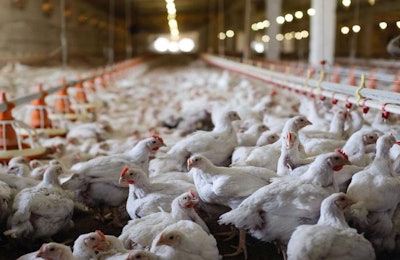
Superdosing phytase in poultry diets can result in improved feed efficiency and growth performance. Superdosing differs from standard phytase dosing by taking the destruction of the phytate in feed ingredients beyond simply providing feed cost savings through the release of phosphorus (P), and eliminates the anti-nutritional effects that phytate has within the digestive tract.
This results in a typical three- to four-point improvement in feed conversion efficiency (FCE) through increased nutrient digestion and utilization, worth an estimated EUR4.60 (US$5.06)/ton of feed. The improvements in digestive efficiency can also reduce litter moisture problems and related foot pad dermatitis, as a direct result of lower excreta moisture content.
Phytate anti-nutrient effects
Phytate has considerable anti-nutrient effects. As well as binding to key minerals such as calcium and zinc, thereby reducing availability and utilization, phytate also has a similar impact on energy and amino acid digestibility.
The traditional application of phytase acts by partly degrading phytate, releasing P in the process; however, what is often not appreciated is the impact of the lower phytate esters left behind. These compounds, which are essentially phytate, which has lost one or more of its six P groups, can also have anti-nutritional effects.
These lower phytate esters – known as IP5, IP4, IP3 IP2 and IP1 (phytate being IP6) – are largely resistant to the action of some commercial phytase enzymes. The broiler’s own phosphatases can degrade IP1, but for the anti-nutritional effects of phytate and its esters to be fully eliminated, the type and dose of phytase used must be able to continue removing P from IP6, IP5, IP4, IP3 and IP2 until all is converted to IP1.
Defining phytase superdosing
With standard phytase dosing, degrading one anti-nutrient (IP6) may create another (IP5), and so on, unless those lower esters can also be destroyed. The most accurate definition of superdosing, therefore, is the application of a sufficiently high dose of a phytase capable of eliminating phytate and preventing any subsequent buildup of lower phytate esters.

Phytase superdosing can result in the total elimination of phytate anti-nutritional effects. With annual global poultry feed production standing at 400 million tons, this could result in EUR1.6 billion (US$1.8 billion) in costs. | AB Vista
Only when this happens can the full benefits of phytase superdosing be reliably achieved, as the potential impact of lower phytate esters is responsible for much of the underperformance seen when unsuitable phytases are used, even at higher doses.
Superdosed phytase must act rapidly to degrade phytate to IP1 to minimize the time during which any anti-nutritional effects are experienced in the animal gut, and continue to act at very low concentrations of phytate and its lower esters to drive toward complete elimination.
Phytase superdosing also delivers performance gains through the inositol remaining once all P has been removed from phytate. This inositol is thought to be responsible for around 30 percent of the total response seen from superdosing.
Impact of inositol
Increased levels of inositol – whether as a result of superdosing degradation of phytate or direct addition of inositol to the diet – has been shown to improve FCE and bodyweight gain in broilers.
Inositol plays an important role in fat metabolism and cell functioning. It can also be combined with phosphate at a cellular level in the broiler to recreate phytate and the lower phytate esters such as IP3 and IP4, all of which have critical functions within the cell despite their negative impact on digestive efficiency.
Superdosing phytase characteristics
Any phytase considered for superdosing must be capable of degrading phytate – and any lower esters produced – and eventually facilitate the release of inositol. However, for this to happen through feed manufacturing and consumption by the bird, the phytase needs to exhibit a number of particular characteristics.

Phytase used in superdosing must exhibit sustained activity, even at low phytate concentrations, for broilers to fully benefit. | AB Vista
The capability to withstand and maintain a high level of activity through high-temperature pelleting and feed processing is critical, as is survival when exposed to the acidic conditions and digestive action of the stomach.
The phytase also needs to be quickly released once ingested, and to act rapidly to minimize anti-nutritional effects and continue acting until phytate and any lower esters have been virtually eliminated. The ultimate goal is to convert as much phytate to IP1 as possible, as quickly as possible, and as reliably as possible.
Optimizing superdosing of phytase in poultry















